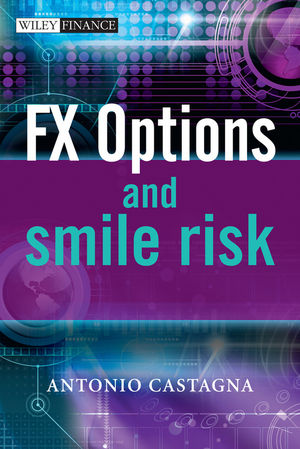FX Options and Smile RiskISBN: 978-0-470-75419-1
Hardcover
320 pages
January 2010
 This is a Print-on-Demand title. It will be printed specifically to fill your order. Please allow an additional 10-15 days delivery time. The book is not returnable.
|
||||||
Notation and Acronyms.
1 The FX Market.
1.1 FX rates and spot contracts.
1.2 Outright and FX swap contracts.
1.3 FX option contracts.
1.4 Main traded FX option structures.
2 Pricing Models for FX Options.
2.1 Principles of option pricing theory.
2.2 The black–scholes model.
2.3 The Heston Model.
2.4 The SABR model.
2.5 The mixture approach.
2.6 Some considerations about the choice of model.
3 Dynamic Hedging and Volatility Trading.
3.1 Preliminary considerations.
3.2 A general framework.
3.3 Hedging with a constant implied volatility.
3.4 Hedging with an updating implied volatility.
3.5 Hedging Vega.
3.6 Hedging Delta, Vega, Vanna and Volga.
3.7 The volatility smile and its phenomenology.
3.8 Local exposures to the volatility smile.
3.9 Scenario hedging and its relationship with Vanna–Volga hedging.
4 The Volatility Surface.
4.1 General definitions.
4.2 Criteria for an efficient and convenient representation of the volatility surface.
4.3 Commonly adopted approaches to building a volatility surface.
4.4 Smile interpolation among strikes: the Vanna–Volga approach.
4.5 Some features of the Vanna–Volga approach.
4.6 An alternative characterization of the Vanna–Volga approach.
4.7 Smile interpolation among expiries: implied volatility term structure.
4.8 Admissible volatility surfaces.
4.9 Taking into account the market butterfly.
4.10 Building the volatility matrix in practice.
5 Plain Vanilla Options.
5.1 Pricing of plain vanilla options.
5.2 Market-making tools.
5.3 Bid/ask spreads for plain vanilla options.
5.4 Cutoff times and spreads.
5.5 Digital options.
5.6 American plain vanilla options.
6 Barrier Options.
6.1 A taxonomy of barrier options.
6.2 Some relationships of barrier option prices.
6.3 Pricing for barrier options in a BS economy.
6.4 Pricing formulae for barrier options.
6.5 One-touch (rebate) and no-touch options.
6.6 Double-barrier options.
6.7 Double-no-touch and double-touch options.
6.8 Probability of hitting a barrier.
6.9 Greek calculation.
6.10 Pricing barrier options in other model settings.
6.11 Pricing barriers with non-standard delivery.
6.12 Market approach to pricing barrier options.
6.13 Bid/ask spreads.
6.14 Monitoring frequency.
7 Other Exotic Options.
7.1 Introduction.
7.2 At-expiry barrier options.
7.3 Window barrier options.
7.4 First–then and knock-in–knock-out barrier options.
7.5 Auto-quanto options.
7.6 Forward start options.
7.7 Variance swaps.
7.8 Compound, asian and lookback options.
8 Risk Management Tools and Analysis.
8.1 Introduction.
8.2 Implementation of the LMUV model.
8.3 Risk monitoring tools.
8.4 Risk analysis of plain vanilla options.
8.5 Risk analysis of digital options.
9 Correlation and FX Options.
9.1 Preliminary considerations.
9.2 Correlation in the BS setting.
9.3 Contracts depending on several FX spot rates.
9.4 Dealing with correlation and volatility smile.
9.5 Linking volatility smiles.
References.
Index.



